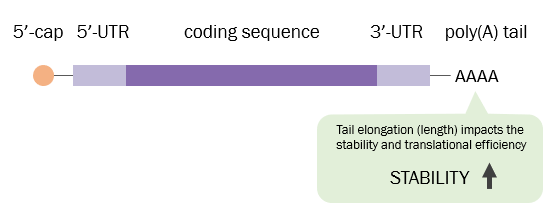The poly(A) tail is an important feature of eukaryotic mRNA, located at the 3′ end and consisting of multiple adenosine residues.It plays multiple roles in mRNA stability: not only does it protect mRNA from degradation by nucleases, but it also enhances translation efficiency by promoting the formation of the translation initiation complex.In addition, it may partially regulate the intracellular localization and transport of mRNA.These combined effects ensure efficient expression and functional implementation of mRNA within cells.
As a critical starting material for in vitro transcription (IVT) to produce mRNA, the design and manufacturing of the plasmid template play a pivotal role in ensuring production speed and quality.For mRNA plasmids carrying a poly(A) tail, stability is closely linked to the length and structure of the poly(A) sequence.However, unlike conventional plasmids, the poly(A) region in mRNA template plasmids often shows instability during replication in E. coli, leading to a higher risk of sequence deletions.A robust and reliable poly(A) plasmid design is therefore essential to secure template integrity and enable efficient, high-yield mRNA synthesis.
Mechanisms Leading to Poly(A) Instability in E. coli
⭕ The sequence characteristics of the mRNA template plasmid, cultivation conditions, and the E. coli strain selected for production all have a direct impact on the integrity of the poly(A) sequence.Many E. coli strains commonly used for plasmid manufacturing, such as DH5 α, DH10B, and JM109, carry mutations in the recA gene, which enhances sequence stability and makes them suitable for producing most types of plasmids. However, these conventional strains are not sufficient to maintain the stability of mRNA plasmids containing a poly(A) tail, and substantial loss of the poly(A) sequence remains a persistent issue.
⭕ Under natural conditions, E. coli possesses various enzymes that recognize errors in its genome and relies on its intrinsic repair mechanisms to correct sequence mutations.The DNA polymerases involved in this process have relatively low fidelity, and the repair activity may lead to the loss of the poly(A) sequence.In addition, recombination events occurring within the poly(A) region can also result in the loss of the poly(A) sequence.
⭕ Some studies have reported that a poly(A) tail of 72 bp can remain intact after cultivation;when the length reaches 172 bp, spontaneous deletion mutations may occur after cultivation;and at 325 bp, the sequence becomes highly unstable, making it difficult to obtain positive clones.

Therefore, improving the stability of poly(A)-tail-containing plasmids has become essential. By rationally designing the polyadenylation signal and vector elements, it is possible to ensure that mRNA undergoes correct post-transcriptional polyadenylation and forms a stable poly(A) tail. Common strategies include:
⭕ Shortening the poly(A) length during plasmid construction. A typical design contains 120 consecutive adenines, although loss can still occur in practice. Some studies have suggested that a non-continuous poly(A) tail, such as 30A–linker–70A, can be more stable.
⭕ Removing destabilizing elements from the vector. In some cases, intrinsic vector components (e.g., sequences expressing toxic proteins) can reduce stability; deleting such elements can yield a more stable poly(A) vector.
⭕ Using ligation instead of recombination during plasmid construction to avoid recombination events that lead to poly(A) loss.
⭕ Reversing the gene orientation relative to the lac promoter in pUC-based vectors to avoid the formation of unstable poly(T) sequences, which can improve stability.
⭕ Deleting the lac promoter to eliminate expression-driven growth inhibition in host cells, further enhancing poly(A) vector stability.
Building on the above strategies, Gene Universal has modified and optimized the existing pUC vectors to produce two types of stable, universal poly(A)-tail-containing vectors — 120A and 110A (30A–linker–70A). These vectors enable the rapid production of mRNA template plasmids carrying a poly(A) tail.This approach allows quick acquisition of poly(A)-tail-containing vectors, significantly reducing production time and cost. The poly(A) tails in these vectors demonstrate good stability during fermentation and serial passaging, with no significant loss of adenine residues observed after 15 passages. In addition, the optimized recombinant vectors maintain greater stability in subsequent applications, achieving a correct poly(A) tail cloning rate of over 85%.
CASE STUDY
Passage Stability of Poly(A) Vectors in E. coli
Table 1. Constructed Universal Poly(A) Vectors: 110A and 120A
| Vector | Category | Linearization Site | Resistance |
|---|---|---|---|
| A1 | A30-L-A70 | BsmBI | Kan |
| A2 | A30-L-A70 | BspQI | Kan |
| B1 | A120 | BsmBI | Kan |
| B2 | A120 | BspQI | Kan |
Minimize allergy risks and environmental impact linked to β-lactam antibiotics (e.g., ampicillin)

Fig. a. 110 bp poly(A) plasmid, 15th passage sequencing

Fig. b. 120 bp poly(A) plasmid, 15th passage sequencing
Plasmids with both poly(A) tail lengths maintained high stability during serial passaging, with the 110 bp non-continuous tail showing superior stability.
Poly(A) Vector Stability Assessment in Gene Synthesis
| Vector | Total Clones Submitted | Clones with Correct Poly(A) | Poly(A) Accuracy Rate |
|---|---|---|---|
| A30-L-A70 | 16 | 15 | 93.75% |
| A120 | 16 | 14 | 87.5% |
| Unmodified A120 | 16 | 9 | 56.25% |
The modified vectors (A120 and A30-L-A70) demonstrated significantly improved stability during the gene synthesis process compared to the unmodified 120A vector.
Gene Universal has a professional technical team with extensive experience in custom mRNA synthesis for research and preclinical applications. Leveraging a mature and comprehensive IVT mRNA custom service platform, the company can provide end-to-end process development services, including mRNA sequence optimization, gene synthesis, plasmid preparation, linearized template preparation, IVT, purification, bulk formulation and lyophilization, and LNP encapsulation.

https://www.geneuniversal.com/
Gene Universal

Average Rating